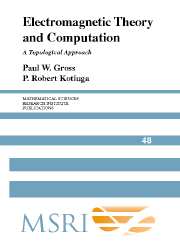Book contents
- Frontmatter
- Table of Contents
- Preface
- Introduction
- 1 From Vector Calculus to Algebraic Topology
- 2 Quasistatic Electromagnetic Fields
- 3 Duality Theorems for Manifolds With Boundary
- 4 The Finite Element Method and Data Structures
- 5 Computing Eddy Currents on Thin Conductors with Scalar Potentials
- 6 An Algorithm to Make Cuts for Magnetic Scalar Potentials
- 7 A Paradigm Problem
- Mathematical Appendix: Manifolds, Differential Forms, Cohomology, Riemannian Structures
- Bibliography
- Summary of Notation
- Examples and Tables
- Index
3 - Duality Theorems for Manifolds With Boundary
Published online by Cambridge University Press: 06 July 2010
- Frontmatter
- Table of Contents
- Preface
- Introduction
- 1 From Vector Calculus to Algebraic Topology
- 2 Quasistatic Electromagnetic Fields
- 3 Duality Theorems for Manifolds With Boundary
- 4 The Finite Element Method and Data Structures
- 5 Computing Eddy Currents on Thin Conductors with Scalar Potentials
- 6 An Algorithm to Make Cuts for Magnetic Scalar Potentials
- 7 A Paradigm Problem
- Mathematical Appendix: Manifolds, Differential Forms, Cohomology, Riemannian Structures
- Bibliography
- Summary of Notation
- Examples and Tables
- Index
Summary
3A. Duality Theorems
The next topic from homology theory which sheds light on the topological aspects of boundary value problems is that of duality theorems. Duality theorems serve three functions, namely to show
(1) a duality between certain sets of lumped electromagnetic parameters which are conjugate in the sense of the Legendre transformation;
(2) the relationship between the generators of the pth homology group of an n-dimensional manifold and the (n−p)-dimensional barriers which must be inserted into the manifold in order to make the pth homology group of the base manifold trivial;
(3) a global duality between compatibility conditions on the sources in a boundary value problem and the gauge transformation or nonuniqueness of a potential.
In order to simplify ideas, the discussion is restricted to manifolds and homology calculated with coefficients in the field ℝ. The duality theorems of interest to us are formulated for orientable n-dimensional manifolds M and have the form
where Ω1 and Ω2 are manifolds having some geometric relation. In general, the geometric relationship of interest to us is that of a manifold and its boundary or the manifold and its complement. A complete development of duality theorems requires the calculus of differential forms, but we will merely state the relevant duality theorems without proof and give examples to illustrate their application. These duality theorems are a result of a nondegenerate bilinear pairing in cohomology classes and integration. The Mathematical Appendix covers details of the exterior product which leads to the necessary bilinear pairing, but for now we note that we note that the exterior product of a p-form and an n − p-form gives an n-form.
Information
- Type
- Chapter
- Information
- Electromagnetic Theory and ComputationA Topological Approach, pp. 99 - 120Publisher: Cambridge University PressPrint publication year: 2004
